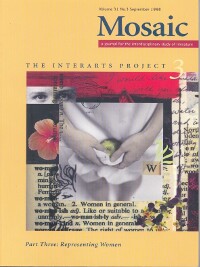Issue 31.3
Overview

Special Issue: The Interarts Project III: Representing Women
Published: September 1998
View the issue introduction or see the issue summary and contents below.
8 essays, totalling 192 pages
$14.95 CAD
Part three of The Interarts Project focuses on the intersections of women, femininity, representation, and art. The history of art and womanhood/femininity, as well as the state of interart and feminist theory, follow similar paths. Can feminism bring any new understanding to interart and media studies, or can it enable applied theorizing that mines media for theoretic data? Essays in this issue explore representations of Ophelia and other beautiful dead women in the visual arts; the poetic debate of Carol Ann Duffy and Robert Browning over females posing nude; how Orlando’s morphologic gender transforms between film and prose; a relationship between the reader, the image, and the poetic in Djuna Barnes; the staging of Emily Carr’s life/work; the literary uneasiness of Stevie Smith’s doodling; landscape painting as closet for lesbian desire; and the collage as female (artistic) form.
Framing Ophelia: Representation and the Pictorial TraditionKaara Peterson Focusing on the way that Ophelia’s death is “reported” in Hamlet and then depicted in a series of visual modes ranging from 18th-century classic paintings to contemporary pop art, this essay explores how the arts, regardless of medium, conventionalize the “death of a beautiful woman.” | |
Exposing Nude Art: Carol Ann Duffy’s Response to Robert BrowningDanette DiMarco Within the framework of recent critiques by women art historians of traditionalist male theorizing about the female body, this essay explores the way that Carol Ann Duffy’s “Standing Female Nude” can be read as a similar challenging of the gender biases that inform Robert Browning’s defense of a Renaissance painter of nudes in his poem, “With Francis Furini.” | |
Sex Change and Media Change: From Woolf’s to Potter’s OrlandoSusan Watkins Comparing the treatment of gender identity and feminist politics in Virginia Woolf’s Orlando and Sally Potter’s film, this essay examines how differences between the two media enable Woolf to embrace a performative conception of gender that makes her treatment of feminist concerns more radical than Potter’s. | |
Troubling the “Master’s Voice”: Djuna Barnes’s Pictorial StrategiesIrene Martyniuk As both a visual and verbal artist, Djuna Barnes demands a dual literacy. Focusing on differences between The Book of Repulsive Women (1915) and Ryder (1928), this essay explores the way that she came to an understanding of how the “illustration” might best function as a means of engaging and destabilizing the reader. | |
Staging a Woman Painter’s Life: Six Versions of Emily CarrAnne F. Nothof The life of Canadian landscape painter Emily Carr has posed a persistent challenge for playwrights, who have accordingly experimented with a variety of techniques to express her individualist lifestyle and vision of the natural world. Focusing on six Carr plays, this essay examines their varying degrees of success in staging the “subjectivity” of such a woman artist. | |
The Dangers of Eccentricity: Stevie Smith’s Doodles and PoetryKristin Bluemel Even readers of Stevie Smith’s poetry who appreciate its comic brilliance tend to shy away from the question of how to interpret the “eccentric” doodles that accompany her funny poems. This feminist essay uses (and interrogates) interarts theory to answer this question through analysis of Smith’s texts of “violent consumption.” | |
Landscape and Female Desire: Elizabeth Bishop’s “Closet” TacticsPriscilla M. Paton Placing Elizabeth Bishop’s poetry in the tradition of landscape depiction, as well as current ecological debates, this essay examines how she feminizes landscape, casting it as an image of her own desire. Focus is on the way she rewrites imperialistic conventions in order to “naturalize” and empower the love and imagination of women. | |
Beyond Fragmentation: Collage as a Feminist StrategyGwen Raaberg Although cultural debates regarding the possibility of a postmodern oppositional art tend to be critical of collage, feminist artists in a variety of media have frequently chosen this mode. Focusing on concrete examples, this essay attempts to provide the historical and theoretical framework needed to understand the oppositional nature of feminist collage. |